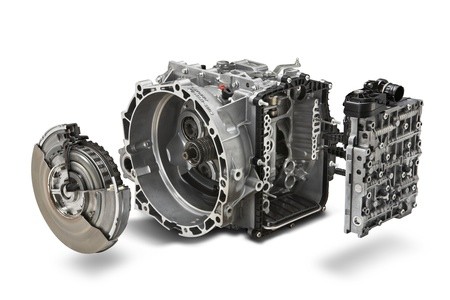Jan 23rd, 2009 by RJ Menezes
Ford has announced that they are releasing their own dual-clutch transmission similar to that of Volkswagen’s DSG gearbox. The new transmission was designed with efficiency, not outright performance, in mind. The aptly-named “PowerShift” gearbox is supplied by Getrag, a world famous gearbox manufacture.
The gearbox will be employed in many of Ford’s other brands including Lincoln and Volvo. It’s first U.S. application is expected to be in the new Fiesta micro-car that will debut sometime this year where it expected to deliver up to 9% better fuel economy in that application.
Here is a copy of the press release from Ford:
FORD TO INTRODUCE FUEL-EFFICIENT DUAL-CLUTCH POWERSHIFT TRANSMISSION IN NORTH AMERICA IN 2010
DETROIT, Jan. 21, 2009 – Ford Motor Company announced today it will introduce an advanced dual-clutch PowerShift six-speed transmission in North America in 2010 for the small-car segment.
PowerShift will deliver the fuel efficiency of a manual gearbox with the convenience and ease of a premium automatic transmission – making it a key enabling technology as Ford targets best-in-class or among-the-best fuel economy with every new vehicle it introduces in North America.
“PowerShift represents a true competitive advantage for Ford and is one of the many technologies that will help our global small-car platforms set a new world standard for efficiency and drive quality,” said Barb Samardzich, vice president, Global Powertrain Engineering, who announced PowerShift’s production timing at the 2009 Automotive News World Congress. “This advanced six-speed is an improvement over today’s automatic transmissions in terms of fuel economy, while providing customers an even more fun-to-drive experience.”
Overall, Ford has committed that almost 100 percent of its transmissions will be advanced six-speed gearboxes by 2013. Six-speed transmissions already have helped vehicles such as the 2010 Ford Fusion achieve best-in-class fuel economy, while at the same time allowing the Ford Flex and Ford Escape to achieve unsurpassed fuel economy in their respective segments.
Ford is leveraging six-speed transmissions, advanced internal combustion engines such as EcoBoost, hybrids, full electric vehicles, vehicle weight reduction and electric power-assisted steering to improve fuel economy and reduce greenhouse gas emissions fleet-wide by 30 percent by 2020.
Automatic Comfort
Compared to traditional automatic four-speed transmissions, PowerShift can help reduce fuel consumption by up to 9 percent depending on the application.
PowerShift provides the full comfort of an automatic with a more sophisticated driving dynamic, thanks to uninterrupted torque from the dual-clutch technology, which consists essentially of two manual transmissions working in parallel, each with its own independent clutch unit. One clutch carries the uneven gears – 1, 3 and 5 – while the other the even gears – 2, 4 and 6. Subsequent gear changes are coordinated between both clutches as they engage and disengage for a seamless delivery of torque to the wheels.
In Europe, Ford currently offers a PowerShift transmission in the Ford Focus. This PowerShift uses a twin wet-clutch system to handle the higher torque levels of the 2.0-liter TDCI engine available in the Focus.
In North America, a dry-clutch derivative of Ford’s PowerShift transmission will be used for added efficiency and durability. A dry clutch transmits power and torque through manual transmission clutch facings, while most automatic transmissions utilize wet clutch plates submerged in oil. As a result, the dry-clutch PowerShift transmission does not require an oil pump or torque converter, providing superior mechanical efficiency.
“A dry clutch is a real sweet spot for lighter vehicle applications,” said Piero Aversa, manager, Ford Automatic Transmission Engineering. “PowerShift is more efficient, it saves weight, is more durable, more efficient and the unit is sealed for life, requiring no regular maintenance.”
PowerShift, unlike conventional automatic transmissions, does not need the heavier torque converter or planetary gears. In addition, the dry-clutch derivative eliminates the need for the weighty pumps, hydraulic fluids, cooling lines and external coolers that wet clutch transmissions require. As a result, the dry-clutch PowerShift transmission can weigh nearly 30 pounds less than, for example, the four-speed automatic transmission featured on today’s Ford Focus.
Differentiating PowerShift even further in terms of its customer appeal is its shift quality, launch feel and overall drive dynamic, which are all facilitated by an expert blend of Ford-exclusive electro-mechanical systems, software features, calibrations and controls. These unique driving features include:
• Neutral coast down – The clutches will disengage when the brakes are applied, improving coasting downshifts and clutch robustness as well as reducing parasitic losses for increased fuel economy.
• Precise clutch control in the form of a clutch slip to provide torsional damping of the engine vibration – This function improves noise, vibration and harshness (NVH) at low engine speeds and enables lower lugging limits for improved fuel economy.
• Low-speed driving or creep mode with integrated brake pressure – This function simulates the low-speed control drivers are accustomed to from an automatic transmission. The amount of rolling torque in Drive and Reverse is precisely controlled, gradually building as brake pressure is released.
• Hill mode or launch assist – Prevents a vehicle from rolling back on a grade by maintaining brake pressure until the engine delivers enough torque to move the vehicle up the hill, providing improved driver confidence, comfort, safety and clutch robustness.
Source: AutoBlog
Photo: Ford Motor Co.

